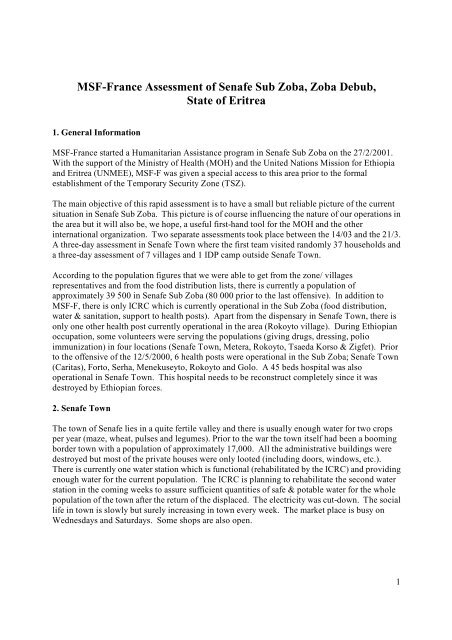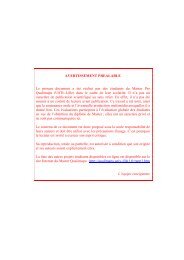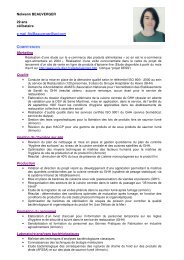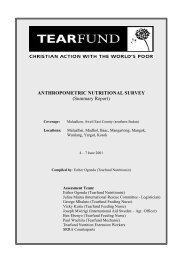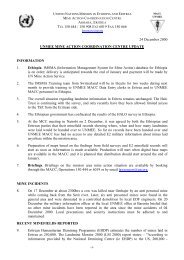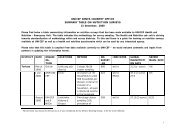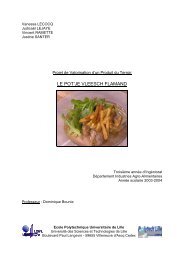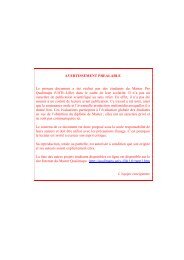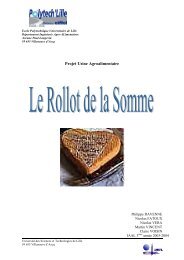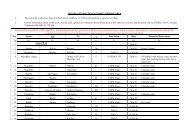MSF-France Assessment of Senafe Sub Zoba, Zoba Debub, State of ...
MSF-France Assessment of Senafe Sub Zoba, Zoba Debub, State of ...
MSF-France Assessment of Senafe Sub Zoba, Zoba Debub, State of ...
Create successful ePaper yourself
Turn your PDF publications into a flip-book with our unique Google optimized e-Paper software.
<strong>MSF</strong>-<strong>France</strong> <strong>Assessment</strong> <strong>of</strong> <strong>Senafe</strong> <strong>Sub</strong> <strong>Zoba</strong>, <strong>Zoba</strong> <strong>Debub</strong>,<br />
<strong>State</strong> <strong>of</strong> Eritrea<br />
1. General Information<br />
<strong>MSF</strong>-<strong>France</strong> started a Humanitarian Assistance program in <strong>Senafe</strong> <strong>Sub</strong> <strong>Zoba</strong> on the 27/2/2001.<br />
With the support <strong>of</strong> the Ministry <strong>of</strong> Health (MOH) and the United Nations Mission for Ethiopia<br />
and Eritrea (UNMEE), <strong>MSF</strong>-F was given a special access to this area prior to the formal<br />
establishment <strong>of</strong> the Temporary Security Zone (TSZ).<br />
The main objective <strong>of</strong> this rapid assessment is to have a small but reliable picture <strong>of</strong> the current<br />
situation in <strong>Senafe</strong> <strong>Sub</strong> <strong>Zoba</strong>. This picture is <strong>of</strong> course influencing the nature <strong>of</strong> our operations in<br />
the area but it will also be, we hope, a useful first-hand tool for the MOH and the other<br />
international organization. Two separate assessments took place between the 14/03 and the 21/3.<br />
A three-day assessment in <strong>Senafe</strong> Town where the first team visited randomly 37 households and<br />
a three-day assessment <strong>of</strong> 7 villages and 1 IDP camp outside <strong>Senafe</strong> Town.<br />
According to the population figures that we were able to get from the zone/ villages<br />
representatives and from the food distribution lists, there is currently a population <strong>of</strong><br />
approximately 39 500 in <strong>Senafe</strong> <strong>Sub</strong> <strong>Zoba</strong> (80 000 prior to the last <strong>of</strong>fensive). In addition to<br />
<strong>MSF</strong>-F, there is only ICRC which is currently operational in the <strong>Sub</strong> <strong>Zoba</strong> (food distribution,<br />
water & sanitation, support to health posts). Apart from the dispensary in <strong>Senafe</strong> Town, there is<br />
only one other health post currently operational in the area (Rokoyto village). During Ethiopian<br />
occupation, some volunteers were serving the populations (giving drugs, dressing, polio<br />
immunization) in four locations (<strong>Senafe</strong> Town, Metera, Rokoyto, Tsaeda Korso & Zigfet). Prior<br />
to the <strong>of</strong>fensive <strong>of</strong> the 12/5/2000, 6 health posts were operational in the <strong>Sub</strong> <strong>Zoba</strong>; <strong>Senafe</strong> Town<br />
(Caritas), Forto, Serha, Menekuseyto, Rokoyto and Golo. A 45 beds hospital was also<br />
operational in <strong>Senafe</strong> Town. This hospital needs to be reconstruct completely since it was<br />
destroyed by Ethiopian forces.<br />
2. <strong>Senafe</strong> Town<br />
The town <strong>of</strong> <strong>Senafe</strong> lies in a quite fertile valley and there is usually enough water for two crops<br />
per year (maze, wheat, pulses and legumes). Prior to the war the town itself had been a booming<br />
border town with a population <strong>of</strong> approximately 17,000. All the administrative buildings were<br />
destroyed but most <strong>of</strong> the private houses were only looted (including doors, windows, etc.).<br />
There is currently one water station which is functional (rehabilitated by the ICRC) and providing<br />
enough water for the current population. The ICRC is planning to rehabilitate the second water<br />
station in the coming weeks to assure sufficient quantities <strong>of</strong> safe & potable water for the whole<br />
population <strong>of</strong> the town after the return <strong>of</strong> the displaced. The electricity was cut-down. The social<br />
life in town is slowly but surely increasing in town every week. The market place is busy on<br />
Wednesdays and Saturdays. Some shops are also open.<br />
1
3. <strong>Senafe</strong> Town/ Demographic Information<br />
<strong>Senafe</strong> is divided into six zones, but includes in its administration three neighboring villages.<br />
The reported current total population and number <strong>of</strong> households per zone, as well as number <strong>of</strong><br />
births and deaths over the last nine months are as follows:<br />
Zone Total # Families # births Total # War related Under 5<br />
Population<br />
deaths deaths deaths<br />
Zone 1 545 135 3 11 3 2<br />
Zone 2 1294 283 2 9 1 3<br />
Zone 3 1072 237 2 5 3 2<br />
Zone 4 1278 276 1 4 0 0<br />
Zone 5 1372 306 3 3 1 1<br />
Zone 6 904 180 4 5 2 1<br />
Zone 7 672 159 3 9 2 1<br />
Matera 920 189 11 6 0 0<br />
Tisha 332 65 0 20 17 2<br />
Afoma 320 105 7 8 7 1<br />
TOTAL 8709 1935 36 80 36 18<br />
These population figures were provided by the zone representatives and are based on lists<br />
prepared for the food distribution. Births and deaths are based solely on recollection because<br />
there were no records kept after the administration left. Based on these grossly under-reported<br />
figures, the Crude Mortality Rate (CMR) for the last 9 months would be approximately <strong>of</strong> 0.5 per<br />
day per 10,000 population (according to WHO standards, a CMR above 1 death per day per<br />
10 000 people indicates an emergency situation). 45% <strong>of</strong> the deaths were war-related (mostly<br />
from Tisha residents who were caught in the crossfire because the town was located between the<br />
two army positions), and 22% were deaths <strong>of</strong> children under 5 years <strong>of</strong> age.<br />
4. <strong>Senafe</strong> Town/ Population Structure<br />
A household sample survey <strong>of</strong> 37 households was done. Houses were randomly chosen, with an<br />
average <strong>of</strong> 3-4 households per zone visited. The population breakdown by age and gender:<br />
Adult males: 9.3%<br />
Adult females: 25.5%<br />
Children over 5 years <strong>of</strong> age: 50.6%<br />
Children under 5 years <strong>of</strong> age: 19.6%<br />
Elderly living alone 4% (8% <strong>of</strong> the households)<br />
Most <strong>of</strong> the male and approximately half <strong>of</strong> the female population were over 50 years <strong>of</strong> age.<br />
Most <strong>of</strong> the families live in their own house, with a minority living in rented homes, or in homes<br />
which had been evacuated nine months ago by relatives. Houses are generally made <strong>of</strong> stone with<br />
tin ro<strong>of</strong>s and are equipped with a wood or kerosene stove, kitchen utensils and beds.<br />
2
5. <strong>Senafe</strong> Town/ Food Supply at Household Level<br />
Even though the household food supply was occasionally under-reported, all the households were<br />
found to have some food:<br />
99% had wheat (an average <strong>of</strong> 4kg/person)<br />
99.5% had oil (an average <strong>of</strong> 0.4 liters/person)<br />
43% had sugar<br />
The survey took place approximately three weeks after the ICRC food distribution and four<br />
weeks after the ICRC wheat distribution. According to ICRC, their food distribution was<br />
intended as a supplement to what the population had as a baseline and included 10.7kg <strong>of</strong> wheat,<br />
1 liter <strong>of</strong> oil, 2 kg <strong>of</strong> pulse, 1 kg <strong>of</strong> sugar, 10.5 kg <strong>of</strong> tea, 0.25 kg <strong>of</strong> salt per person per month, and<br />
soap. Food was distributed per family.<br />
In zones 1-7 and in Tisha, none <strong>of</strong> the families visited owned any animals. However the<br />
neighboring villages <strong>of</strong> Afoma and Matera have land for agriculture and animal rearing, and more<br />
than 50% <strong>of</strong> the population in these two villages own oxen, goats, sheep and/or donkeys. Afoma<br />
has four wells, but the water pumps were removed by the soldiers, and therefore now depend on<br />
rain for their crops.<br />
6. <strong>Senafe</strong> Town/ Health and Nutrition<br />
The nutritional status <strong>of</strong> children under 5 years <strong>of</strong> age was assessed during the household survey.<br />
Of the 40 children reported in the 37 families visited, 28 had a green MUAC (normal), and 5 had<br />
a yellow MUAC but wt/ht over 80% (normal). Of the 7 children not checked, 4 were absent, and<br />
3 were
weekly activity reports. During the last nine months, the
In terms <strong>of</strong> water and sanitation, the population is going directly to the river to fetch water. There is<br />
a spring down in the country side. The water points in town were destroyed. There is clearly<br />
problems in terms <strong>of</strong> sanitation/ hygiene among the population, particularly when you look at the<br />
condition <strong>of</strong> the children. During Ethiopian occupation, the population got 4 food rations and since<br />
Ethiopians withdraw, they are receiving the monthly food ration from the ICRC in Tsaeda Korso<br />
(one time already). The school was also destroyed.<br />
10. Tsaeda Korso Village<br />
There is currently approx. 450 people living in this village which is located few kilometers north<br />
<strong>of</strong> Serha village on the main road between <strong>Senafe</strong> Town and Zalambesa. The population<br />
configuration is quite the same as in Serha. This village is intact except for the 5 water pumps<br />
which were destroyed. The population is currently going to Serha to fetch water from the river.<br />
The ICRC monthly food distribution for 68 villages is currently done in this village (one time<br />
already). Like for Serha, the population reported 4 food distributions during Ethiopian<br />
occupation. The school is close. Prior to the last <strong>of</strong>fensive, the population was going to Forto<br />
health post (managed by the MOH).<br />
During Ethiopian occupation, a health post was functioning and supported by the ICRC in this<br />
location. The building which was used at that time is still intact. Consultation room, dressing<br />
room and pharmacy were operational. Emergency cases were transferred to Adi Grat. This<br />
health post closed when the Ethiopian forces withdraw from the area (19/02/2001) and now, the<br />
population is coming to <strong>Senafe</strong> Town for health services. Polio vaccination was also done during<br />
Ethiopian occupation. Three people over 50 years <strong>of</strong> age died in the past ten months in the area<br />
(chronicle disease cases). But the nutritional & health status <strong>of</strong> this population seems stable and<br />
no specific morbidity pattern was reported to us. The main issue now is access to health services<br />
(like for Serha village) since the population have to walk to <strong>Senafe</strong> Town to get medical care<br />
(more then two hours <strong>of</strong> walk). Here also, problems seems to be more related to the water &<br />
sanitation situation (access to safe & potable water, hygiene conditions).<br />
11. Forto Village<br />
This village is located few kilometers north <strong>of</strong> Tsaeda Korso village on the main road between<br />
<strong>Senafe</strong> Town and Zalambessa. The distance between Forto and Tsaeda Korso is <strong>of</strong> approx.<br />
10 kilometers. The population <strong>of</strong> the village and surroundings if <strong>of</strong> approx. 500 people. An<br />
MOH health post was operational in this village prior to the last <strong>of</strong>fensive. The structure needs<br />
rehabilitation work (ro<strong>of</strong>, windows, doors) but the structure is intact. Same situation for the<br />
school, which is close. Private houses are also intact.<br />
The humanitarian picture (food, health, nutrition, sanitation/ hygiene) is the same as the one<br />
described for Tsaeda Korso village. In terms <strong>of</strong> access to safe & potable water, the population is<br />
fetching water from a well in the village, but this well needs rehabilitation work as soon as<br />
possible since it is open & not protected (animals are going there, the distribution area is very<br />
dirty, etc.). A
12. Rokoyto Village<br />
The humanitarian situation in this village is the most positive one that we were able to see outside<br />
<strong>of</strong> <strong>Senafe</strong> Town. A health post serving 40 surrounding villages is operational with one health<br />
assistant (between 10 and 30 consultations per day), a water distribution point was rehabilitated<br />
by the ICRC and is providing sufficient water to the whole population <strong>of</strong> the agglomeration and<br />
for the animals. The private houses are intact and good number <strong>of</strong> goats & cattle were seen in the<br />
area. People are also cultivating. This village is at approximately 45 minutes <strong>of</strong> drive west from<br />
Forto village. The current population <strong>of</strong> the village is <strong>of</strong> approx. 600 people and 3000 people<br />
were living here prior to the last <strong>of</strong>fensive. For the food distribution situation, the same pattern as<br />
described above during Ethiopian occupation and since the withdrawal. But the population is<br />
complaining that the ICRC food distribution is not enough (no milk, no DMK). The school was<br />
looted but the structure is intact.<br />
The morbidity patterns are the one for a normal health post (malaria, pneumonia, eye disease,<br />
anemia, respiratory infection, diarrhea, gastritis, abdominal pain, etc.). No specific morbidity<br />
patterns that we can link with a potential epidemic. Again here, polio vaccination was done<br />
during Ethiopian occupation. During Ethiopian occupation, 3 deaths were reported by the health<br />
assistant; 2 tuberculosis cases and 1 malaria case (all >50 years old). There is no sign <strong>of</strong><br />
malnutrition among the
ack in the <strong>Sub</strong> <strong>Zoba</strong>, a quick decision will have to be taken about this caseload. If the village <strong>of</strong><br />
origin is falling inside the TSZ, the best option is a fast return there. If it is not falling inside the<br />
TSZ, the best option is to resettle this displaced population to a less remote area near <strong>Senafe</strong><br />
Town where they will have easier access to health services, humanitarian assistance, etc.<br />
14. Menekuseyto Village<br />
This village is located at the extreme south <strong>of</strong> the <strong>Sub</strong> <strong>Zoba</strong>, very close to the southern boundary<br />
<strong>of</strong> the TSZ, at approximately 25 kilometers from <strong>Senafe</strong> Town. The current population is <strong>of</strong><br />
approx. 300 people and prior to the last <strong>of</strong>fensive, 800 people were living here. It is the only<br />
village where we were not able to find any counterpart. The population is still living in fear and<br />
we can presume, according to some individual interviews, that there is still an Ethiopian presence<br />
in the area (or so called Eritrean opposition). The population is cultivating and there is a good<br />
number <strong>of</strong> cattle/ goats in the area.<br />
The population is mostly a mix <strong>of</strong> children, women and elderly people. The health post is intact<br />
but closed one year ago. Small scale rehabilitation work needs to be done, mostly for the water<br />
supply (windows, doors, ro<strong>of</strong> and even material inside the structure were not looted). During<br />
Ethiopian occupation, a priest was giving basic drugs to the population which had otherwise<br />
access to the health post <strong>of</strong> Zigfet (operational during Ethiopian occupation). The 50 years old TB cases and 2
the population is quite the same as what was seen in the other villages that we visited. Diarrhea<br />
cases are most probably linked to the problem <strong>of</strong> access to safe & potable water. A well located<br />
in the town was destroyed, so now the population is going directly to the river to fetch water.<br />
17. Conclusions<br />
The general health and nutritional status <strong>of</strong> the population in <strong>Senafe</strong> <strong>Sub</strong> <strong>Zoba</strong> remained stable<br />
during the last nine months. The mortality patterns reflect the direct effect <strong>of</strong> war more than a<br />
change in morbidity patterns. The current health needs are those typical <strong>of</strong> the age groups<br />
remaining behind, and the psychological consequences <strong>of</strong> war. One <strong>of</strong> the main problem is about<br />
easy access to health services since there is currently only one health posts operational for the<br />
whole <strong>Sub</strong> <strong>Zoba</strong> outside <strong>of</strong> <strong>Senafe</strong> Town. The second one is about access to safe and potable<br />
water and sanitation.<br />
The current fragile but stable situation in terms <strong>of</strong> health & nutritional status <strong>of</strong> the population<br />
can potentially be disturb by the return <strong>of</strong> the displaced populations. Population figures will<br />
double and the pressure in terms <strong>of</strong> access to water, food and health services can potentially be<br />
problematic if no rapid humanitarian response is organize prior to the return from the camps.<br />
An additional information is about the health post <strong>of</strong> Golo village (approximately 20 kilometers<br />
north <strong>of</strong> <strong>Senafe</strong> Town, few kilometers north <strong>of</strong> the TSZ), which was operated by the MOH prior<br />
to the last <strong>of</strong>fensive. This health post was closed when the MOH withdraw in May 2000. The<br />
structure was looted but intact with a need for rehabilitation work (doors, windows, ro<strong>of</strong>). The<br />
population <strong>of</strong> that area (approx. 750 people in Golo village and ten surrounding villages) is<br />
currently coming to <strong>Senafe</strong> Town for health services.<br />
There will be a need for Measles vaccine campaign, as this was not done along with Polio. To<br />
make it easier, <strong>MSF</strong>-F will do the campaign before the IDP’s return to <strong>Senafe</strong>.<br />
The nutritional status has remained stable, and so far there seems to be no indication for<br />
development <strong>of</strong> targeted supplementary feeding programs in the town <strong>of</strong> <strong>Senafe</strong>.<br />
8


